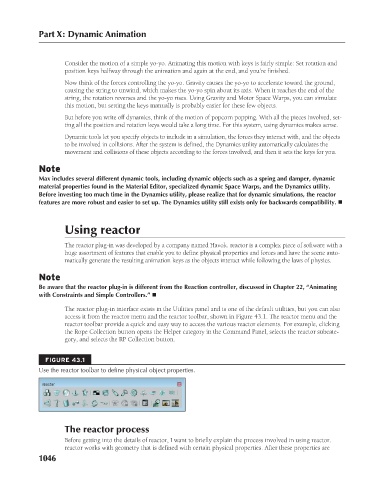Page 1094 - Kitab3DsMax
P. 1094
Part X: Dynamic Animation
Consider the motion of a simple yo-yo. Animating this motion with keys is fairly simple: Set rotation and
position keys halfway through the animation and again at the end, and you’re finished.
Now think of the forces controlling the yo-yo. Gravity causes the yo-yo to accelerate toward the ground,
causing the string to unwind, which makes the yo-yo spin about its axis. When it reaches the end of the
string, the rotation reverses and the yo-yo rises. Using Gravity and Motor Space Warps, you can simulate
this motion, but setting the keys manually is probably easier for these few objects.
But before you write off dynamics, think of the motion of popcorn popping. With all the pieces involved, set-
ting all the position and rotation keys would take a long time. For this system, using dynamics makes sense.
Dynamic tools let you specify objects to include in a simulation, the forces they interact with, and the objects
to be involved in collisions. After the system is defined, the Dynamics utility automatically calculates the
movement and collisions of these objects according to the forces involved, and then it sets the keys for you.
Note
Max includes several different dynamic tools, including dynamic objects such as a spring and damper, dynamic
material properties found in the Material Editor, specialized dynamic Space Warps, and the Dynamics utility.
Before investing too much time in the Dynamics utility, please realize that for dynamic simulations, the reactor
features are more robust and easier to set up. The Dynamics utility still exists only for backwards compatibility. n
Using reactor
The reactor plug-in was developed by a company named Havok. reactor is a complex piece of software with a
huge assortment of features that enable you to define physical properties and forces and have the scene auto-
matically generate the resulting animation keys as the objects interact while following the laws of physics.
Note
Be aware that the reactor plug-in is different from the Reaction controller, discussed in Chapter 22, “Animating
with Constraints and Simple Controllers.” n
The reactor plug-in interface exists in the Utilities panel and is one of the default utilities, but you can also
access it from the reactor menu and the reactor toolbar, shown in Figure 43.1. The reactor menu and the
reactor toolbar provide a quick and easy way to access the various reactor elements. For example, clicking
the Rope Collection button opens the Helper category in the Command Panel, selects the reactor subcate-
gory, and selects the RP Collection button.
FIGURE 43.1
Use the reactor toolbar to define physical object properties.
The reactor process
Before getting into the details of reactor, I want to briefly explain the process involved in using reactor.
reactor works with geometry that is defined with certain physical properties. After these properties are
1046

